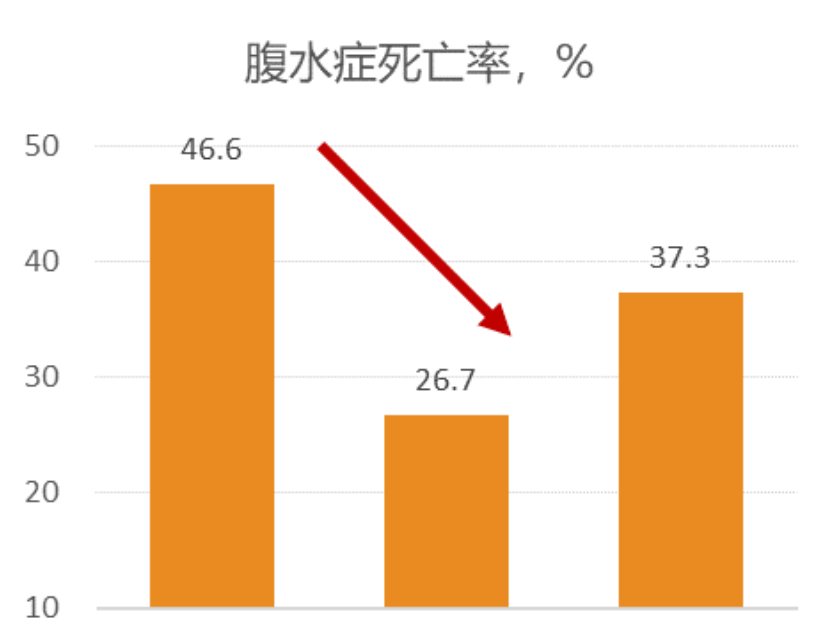 View More
View More
Modern broilers have the advantages of rapid growth, high metabolic rate and strong protein deposition capacity, which requires the lungs and cardiovascular system to supply more oxygen to the body. In low temperature environment or high altitude low oxygen environment in winter, broilers are prone to hypoxemia, increased cardiac blood transfusion, pulmonary hypertension, right ventricular hypertrophy and other symptoms, and eventually ascites or death. According to statistics, the mortality rate of broiler ascites (or pulmonary hypertension syndrome) in winter is as high as 20%, which is one of the main causes of death of modern broilers.
Due to the lack of a complete urea cycle, arginine is an essential amino acid for poultry to participate in key metabolic pathways and is mainly dependent on dietary supply. Arginine is a precursor of key metabolites such as nitric oxide (NO), creatine, polyamine, ornithine, citroline, and proline, and can also enhance the secretion of insulin, growth hormone, and insulin-like growth factor 1 in animals. Among them, NO is a key cytokine that promotes the development and regeneration of blood vessels, and has the function of dilating blood vessels and promoting blood circulation.
Glutamine provides the main energy source for the proliferation and development of broiler intestinal epithelial cells, and plays an important role in intestinal immunity, mucin synthesis, mucosal structure maintenance, intestinal functional integrity and resistance to pathogen attack. In this study, the effects of different levels of arginine and glutamine supplementation on growth performance and ascites mortality of broilers at high altitude and low temperature were studied to provide reference for improving ascites of broilers in winter.
Test result
1. Growth performance
Compared with 100%ARG group, the daily gain of broilers in 130%ARG and 160%ARG groups at 7-42 days of age was increased by 2.27 and 1.61g/d, body gain was increased by 79.45 and 56.35g, respectively, and FCR was decreased by 0.19, but no significant changes were observed (P> 0.05).

Arginine level (compared to requirement)
Arginine level (compared to requirement)

Dietary arginine level (compared to requirement)
At 100% arginine requirement, compared with the control group (glutamine supplemental 0), the daily gain in 0.5% glutamine group was significantly increased (P<0.05), but there was no significant change in daily gain in 0.1% glutamine group (P>0.05).

Amount of glutamine added
Compared with 100%ARG group, the average daily weight gain of broilers in 130%ARG and 160%ARG groups increased by 1.78 and 3.62g/d, respectively, when the glutamine supplemental level was 0.5%. Among all treatment groups, the average daily weight gain of broilers in 0.5% glutamine +160% arginine group was the highest (42.68g/d), followed by that in 0.5% glutamine +130% arginine group (40.84g/d), but there was no significant difference in average daily weight gain between the two groups (P> 0.05).

The average daily weight gain of broilers in 100%ARG groups, 130%ARG groups and 160%ARG groups was not significantly changed when the glutamine supplemental level was 1%. When arginine level was 130%, the average daily weight gain of broilers in 0.5% glutamine group was higher than that in no glutamine group and 1% glutamine group, but the difference was not significant (P> 0.05). When arginine level was 160%, the average daily weight gain of broilers in 0.5% glutamine group was significantly higher than that in the other two groups (P<0.05).
2. Mortality rate of ascites
The effect of arginine on ascites mortality of broilers in cold environment was studied without glutamine. The results showed that compared with 100%ARG group, the mortality of broilers with ascites in 130%ARG group decreased by 19.93% (46.6%→26.67%) and 42.12%. Compared with 100%ARG group, the mortality of broilers with ascites in 160%ARG group was lower than that in 130%ARG group.

Dietary arginine level (compared to requirement)
At 100% arginine requirement level, the mortality of broilers with ascites in 0.5% and 1% glutamine groups was lower than that in CON group (46.6%→17.33%/18.67%), and the mortality of broilers with ascites in 0.5% glutamine group and 1% glutamine group had no significant difference.
Compared with the control group (no glutamine and 100% arginine level), the mortality rate of ascites in broilers supplemented with 0.5% glutamine and 130% arginine level was significantly decreased (P<0.05, 46.6%→14.67%), a decrease of nearly 69%.

Compared with the control group (100% arginine level), the right ventricular to total ventricular ratio of broilers in 130% arginine level group was significantly lower (P<0.05, RV/TV 0.7.3 VS 0.15).

Dietary arginine level (compared to requirement)
Hypoxia induced by high altitude is the main factor inducing ascites in broilers. The reason is that low level of nitric oxide (NO) and low temperature promote hematocrit reduction and pulmonary vasoconstriction, and then lower hematocrit leads to increased blood viscosity and blood flow resistance. The right ventricle of broilers needs to generate higher pulmonary artery pressure to pump viscous blood into the narrow pulmonary vascular system, which is reflected in the increased right ventricle proportion of broilers at high altitude and low temperature.
High dietary arginine level (130%) promoted the expression of NO synthetase in blood vessels and increased the plasma NO synthesis at physiological level. NO can dilate blood vessels and promote capillary angiogenesis. High arginine level (130%) showed a decreasing trend of pulmonary hypertension in chickens with low right ventricular proportion.
Conclusion
High arginine level (130% requirement) or 0.5% glutamine alone can improve the growth performance of broilers aged 7-42 days, and significantly reduce the mortality of broilers with ascites in cold
weather.
Under the conditions of this experiment, the combination of 130% arginine level and 0.5% glutamine supplementation could significantly reduce the mortality of ascites in broilers, and the growth performance was the best.